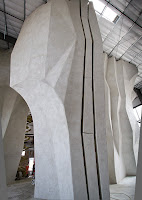As part of the climbing wall build for MetalMark in Fresno, Touchstone wanted to create our first adjustable crack. To do this, Touchstone needed a solution for the movement of a set of interior wall pieces within a larger cutout of the walls. We observed the idea at Planet Granite in San Francisco, and whether they came up with it or not, it is very clever. As they were protective of their system, we endeavored to invent one on our own.

To do that, we turned to 18 year old Daniel Melvin. His first prototype involved a solid steel bar with a sleeve fit to a few thousands of an inch. The bar is welded to the sides – or the main wall. The sleeve is attached to both the interior wall section, and an acme threaded rod via a long nut. Turning the screw (rod) moves the wall section. The implementation is such that one of these units is placed at the top of a wall section behind the wall. This necessitated a method of linking the top of one section with the bottom of another, achieved initially with a set of bolts threaded between sections.
The first prototype works fairly well, but has a very slight tendency to catch as the weight of the wall torques the bar. Prototype two, which is currently in place uses two bars, an acme threaded rod, and a long nut affixed to the wall section and the sleeve. The first prototype also included a 90 degree angle drive to allow movement of the crack to be performed from the front of the wall through a normal t-nut hole, although our current thinking is that this might be just a bit too convenient in practice.
See the photo below to get a better idea. We’re pretty confident we can improve this design for our next adjustable crack, but maybe someone else can do even better in the mean time. In general it works exceedingly well, although our cracks are slightly too big, making for two fist cracks when evenly placed, where every trad climber knows that it should be two hand cracks in that configuration.


